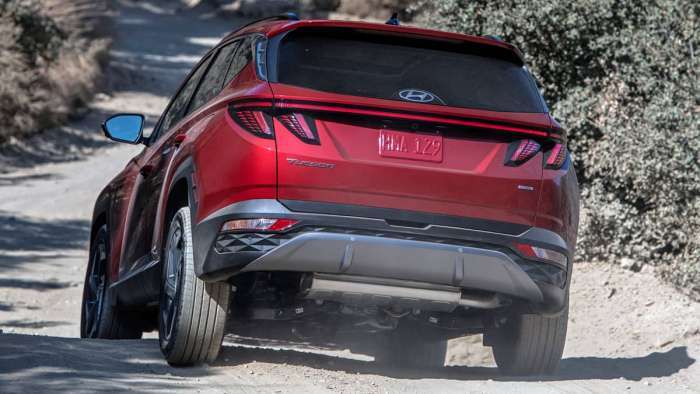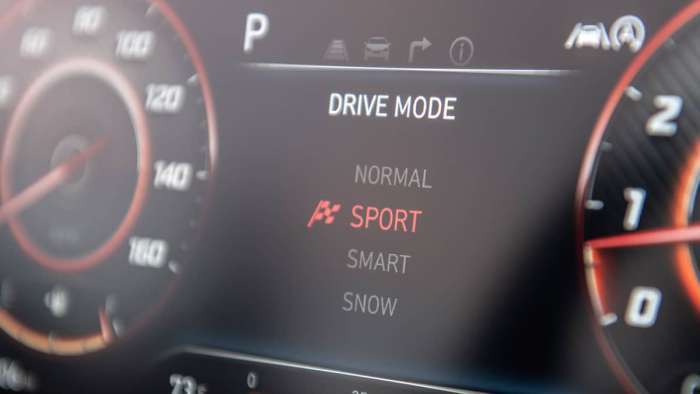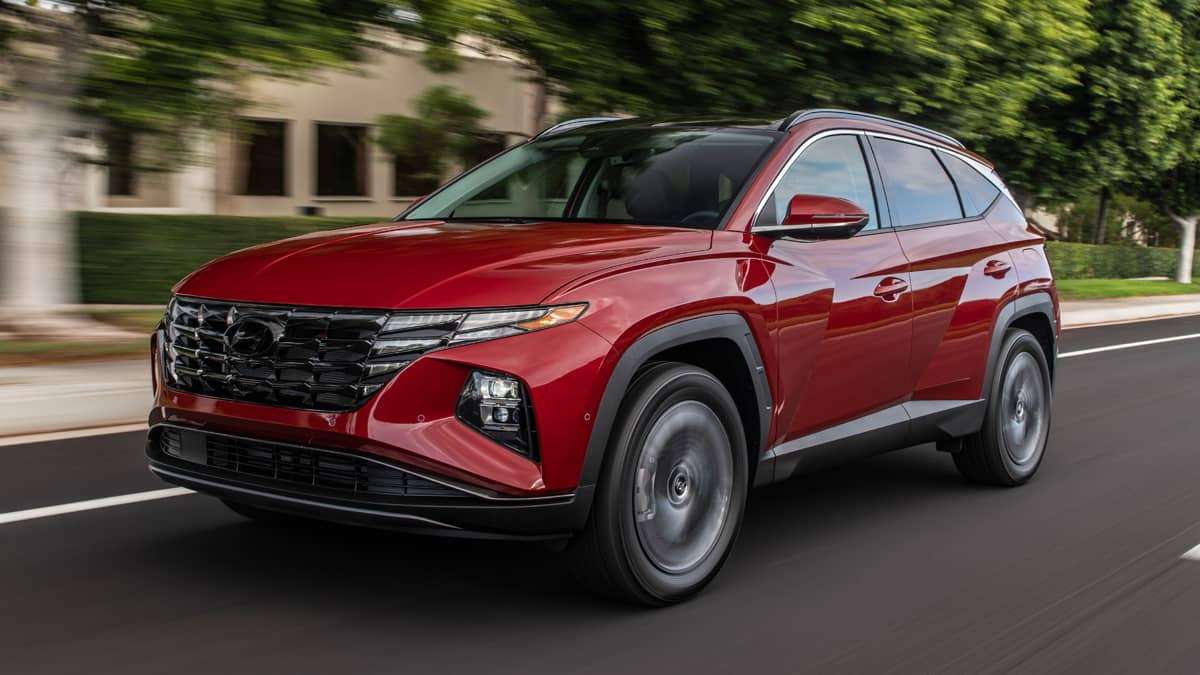Following its recent global introduction, the 2022 Hyundai Tucson for the U.S. market was unveiled today. A lot rides on the success of the compact crossover, which is Hyundai’s top seller both in the U.S. and globally.
The first thing one will notice is the 2022 Hyundai Tucson is bigger both inside and out than the 2020 Tucson. Overall, it is 6.1 inches longer and the wheelbase increases 3.4 inches. Passenger volume is up 6 cubic feet, while cargo space grows by 7.7 cubic feet.
There’s more power available under the hood. The new Tucson offers both a Smartstream 2.5-liter, direct-injected and multi-port-injected gasoline engine as well as 1.6-liter, direct-injected, turbocharged hybrid and plug-in hybrid powertrains.
The Smartstream 2.5-liter engine, with high-efficiency combustion, cooled EGR and an optimized ITMS cooling system, delivers 187 horsepower (up from 181 horsepower) at 6,100 rpm and 178 lb.-ft. of torque (up from 171) at 4,000 rpm, with a targeted combined fuel economy of 28 mpg with front-wheel drive, an overall improvement of 3 mpg combined. This 2.5-liter engine couples to an 8-speed automatic transmission.
 Hybrid and Plug-In Powertrains
Hybrid and Plug-In Powertrains
The hybrid powertrain 1.6-liter turbocharged gasoline engine produces an estimated 177 horsepower and 195 lb.-ft. of torque, with an estimated 226 total system combined horsepower. The hybrid powertrain also produces an estimated 258 lb.-ft. of torque from the combined hybrid powertrain, with a 44.2 kW electric motor and a 1.49 kWh battery pack.
The hybrid powertrain delivers this power through an HEV-tuned six-speed automatic transmission. Combined, this hybrid powertrain is 30% more fuel efficient than the standard gasoline engine, with 20% more torque for effortless daily driving. This efficiency also provides for over 500 miles of range before refueling for greater driving convenience.
Plug-in hybrid models feature a high-output 1.6-liter turbocharged, direct-injected hybrid powertrain coupled with a six-speed automatic transmission. The plug-in hybrid battery is larger than the hybrid battery, with 13.8 kWh of power, yielding an estimated all-electric range of 28 miles and estimated fuel economy of over 70 MPGe. PHEV level-2 charging capability takes less than two hours to recharge the system, using a 7.2kW on-board charger. The plug-in hybrid powerplant delivers power through a PHEV-tuned six-speed automatic transmission.
Handling
Tucson offers Hyundai’s HTRAC All-Wheel-Drive (AWD) system. The HTRAC AWD multi-mode system provides an electronic, variable-torque-split clutch with active torque control between the front and rear axles. The driver-selectable HTRAC normal, sport and smart modes adjust to different conditions.
The sport setting sends more torque to the rear wheels when needed. This system has a wider range of torque distribution variability than many competitors and is tuned to conditions such as straight-line acceleration, medium- and high-speed cornering, and hill starts.
Could the hybrid models handle better? It seems so. Tucson hybrid models feature Hyundai’s e-handling technology, which applies electric motor torque control according to dynamic inputs and road conditions to improve cornering performance.
As the Tucson hybrid turns-in to a corner, the electric motor system applies precise incremental braking force to the front wheels, increasing their tire contact patch on the road surface for enhanced traction and steering response while initiating turn-in. Then, as the vehicle moves to exit the corner, the electric motor applies precise torque to the rear axle, increasing the rear tire contact patches for enhanced traction and control accelerating out of the corner.
 Interior
Interior
One fascinating interior feature, unique to the market, is a temperature-adjusting system providing diffused airflow on the front passengers. It reduces, as Hyundai says, “potentially unpleasant airflow.” No longer will the front-seat passenger slam the vents shut to avoid blasts of cold air, thus slamming the driver with stronger airflow.
Two other new interior technologies are a 10.25-inch full-touch screen exempt of hard buttons and a hoodless digital gauge cluster. The latter sounds interesting but we will reserve judgment until testing it in bright sunlight.
Tucson’s second-row seats feature fold-and-dive functionality for easily optimized reconfiguration capability between passengers and cargo. For extra convenience, a release lever for this function is also located in the rear cargo area.
Segment-first Exclusive Features
Tucson offers a number of segment-first exclusive features including remote smart park assist, which allows owners to park and retrieve their Tucson from the tightest of parking spaces from outside the vehicle, a very convenient feature. Before a driver attempts to load passengers or luggage, the remote parking function can prove particularly useful, bringing the vehicle out of a tight space. The driver uses the smart key to drive the SUV forward or backward, into or out of a parking space, garage or any tight parking situation.
The Tucson also features remote start with heated and ventilated seats. It uses a cellular data connection via the Blue Link app that allows an owner to warm up or cool down the Tucson remotely. This remote heating and cooling function includes heating and ventilation for the front seats.
Digital Key is a segment-exclusive feature, supported via a dedicated smartphone app. The Hyundai Digital Key app also allows smartphones to control selected vehicle systems remotely. Users can lock and unlock the vehicle, activate the panic alert and start the engine.
Digital Key allows owners to leave traditional keys at home and allows secure sharing of keys with family and friends. Digital Key is currently compatible only with phones using the Android operating system.
Tucson now offers an eight-inch color touchscreen coupled with wireless Apple CarPlay and Android Auto to make staying connected easier than ever. Wireless pairing automatically connects an Android or Apple smartphone, so the driver can keep their phone in a pocket, backpack or purse. Owners can also conveniently drop it on an available Qi wireless charger.
Availability
Tucson gasoline and hybrid models will begin availability for the U.S. market in spring 2021, with plug-in models available in summer 2021. The new 2022 Tucson internal combustion models will be produced at Hyundai Motor Manufacturing Alabama and Ulsan, Korea.
Keith Griffin covers Hyundai and Kia at Torque News. He has been writing continuously about cars since 2002. Keith used to be a researcher/writer for US News & World Report, as well as numerous car sites, including Carfax and Car Gurus, and a contributor to The Boston Globe. Most recently, Keith was the managing editor for American Business Media. Follow Keith at @indepthauto on Twitter and on @LinkedIn.






Comments
I've rented a couple Tucsons
Permalink
I've rented a couple Tucsons before, and they have been very nice vehicles. If the production 2022 Tucson Blue Plug-in Hybrid gets close to the prices (after subsidies) of the Honda CR-V Hybrid, and RAV 4 Hybrid, and stays well under the final prices of the Nissan Ariya, and Toyota RAV 4 Prime, then the vehicle will be a sales hit.